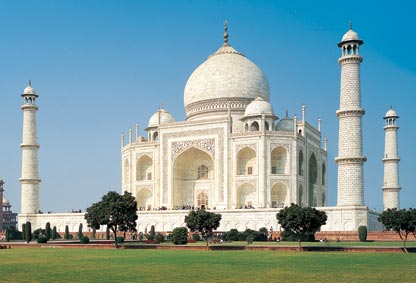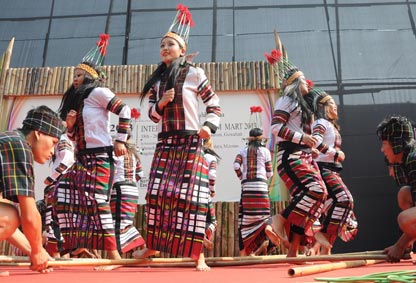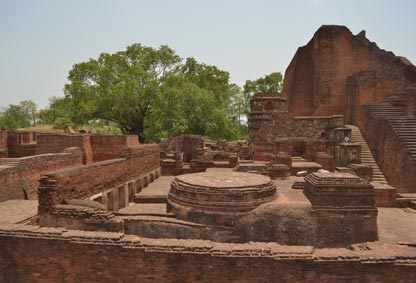



Duration: 13 nights - 14 days
Locations: Delhi - Bhubaneswar - Puri - Calcutta - Bagdogara - Darjeeling - Gangtok - Kalimpong - Bagdogara - Delhi
| Tour Highlights | |
| Delhi | Red Fort, Raj Ghat, Jama Masjid, Chandni Chowk , India Gate, President House, Humayun Tomb & Qutub Minar |
| Bhubaneswar | Temples Lingaraja, Parashurameshwara & Mukteswara |
| Lalitgiri & Ratnagiri |
Buddhist Complex |
| Udaigiri | Monasteries, Caves both Jain & Buddhist |
| Dhauli | Peace Pagoda known as the Shanti Stupa |
| Konark | Sun Temple |
| Puri | Jagannath Temple, Beach |
| Calcutta | Victoria Memorial, Howarh Bridge. |
| Darjeeling | Tiger Hill, Ghoom, Chholing & Darli Monasteries, Darjeeling Himalayan Railway ,Mountaineering Institute & Observatory Hill |
| Gangtok | Research Institute of Tibetology, Tsongo Lake, Do Drul Chorten, Rumtek Monastery, Himalayan Zoological Park, Government Institute of Cottage Industries, Lal bazaar |
| Kalimpong | Thongsa Gompa, Zong Dog Palri Fo-Brang Gompa, Tharpa Choeling Monastery, Dr Graham's Home |
Detailed Itinerary
Day 01: Arrive Delhi
Arrive by International flight, after traditional 'Swagat' (Welcome) our representative would assist you at airport & transfer to hotel for check in.
Delhi is a bustling metropolis, which successfully combines in its folds the ancient with modern. Its strategic location was the prime reasons why successive dynasties chose it as their seat of power. In fact, more mythological cities are believed to be here, like the city of Indraprastha from the Hindu epic Mahabharata, founded around 5000 BC. Numerous monuments were built over several centuries by different rulers like Qutub-ud-din Aibek, Alauddin Khilji, Tughlaks, Humayun & Shah Jahan, who built the Walled City Shah Jahanabad.
Later in first half of 20th century much of New Delhi was planned by Sir Edwin Lutyens, who laid out a grandiose central administrative area as a testament to British rule in India. The division in walled city & New Delhi also marks the division in life styles.
Overnight Hotel - Delhi (B)
Day 02: Delhi
Today we take a guided tour of Old Delhi, the 17th century walled city of Shah Jehanabad, Visiting the great Jama Masjid, the principal mosque of Old Delhi. Built in the year 1656 AD by the Mughal Emperor Shah Jahan, it is the largest & best known mosque in India. Later we walk down or take a rickshaw ride through Chandi Chowk, the old marketplace of Shah Jahanabad now a picturesque bazaar to reach Red Fort, built in the year 1648 by Shah Jehan.
In New Delhi, we visit Raj Ghat, memorial to the Father of the Nation, Mahatma Gandhi. It is a simple black marble platform that marks the spot of his cremation on 31 January 1948. Further we drive past India Gate, memorial built in the year 1931 to commemorate the Indian soldiers who died in the World War I & the Afghan Wars. The names of the soldiers who died in these wars are inscribed on the walls. President's House, the official residence of the President of India, built in 1931. Until 1950 it was known as Viceroy's House & served as the residence of the Governor-General of British India. We will also visit Humayun's Tomb, memorial of Mughal Emperor Humayun, built in the year 1562. The complex is a World Heritage Site & the first example of this type of Mughal architecture in India. Qutub Minar, built in the year 1206 by Qutub-ud-din Aybak. It is the tallest (72m) brick minaret in the world, an important example of Indo-Islamic Architecture. Qutub Minar & its monuments are listed as a UNESCO World Heritage Site.
Overnight Hotel - Delhi (B)
Day 03: Delhi - Bhubaneswar (By Morning Flight)
Today we take a flight to Bhubaneswar , the temple city of India. Once the capital of ancient Kalinga, the city has a long history & is today a bustling centre for commerce & religious activity. These temples are unique in themselves, not only in their architectural beauty but also in the wonderful sculptures. These temples epitomize a comprehensive history of Odishan style of temple architecture from its very inception to perfection spreading almost to 2000 years from 3rd century BC to 16th Century AD.
Half Day Tour
Later we take a tour of Bhubaneswar visiting Lord Shiva Lingaraja Temple, the 11th century temple of Bhubaneswar has been described as "truest fusion of dream & reality." A rare masterpiece, the temple has been rated one of the finest examples of purely Hindu temple. Every inch of the 55 m-high Lingaraja temple is covered with elaborate carvings. Sculpture & architecture fused elegantly to create a perfect harmony. Next we visit Mukteshwara Temple, a 7th-8th century AD is one of the most ornate temples in Bhubaneswar. The intricate carvings of the deities stand testimony to the influence of Hindu, Buddha & Jain style of architecture. The carvings on the roof are specially striking.
We also visit Parashurameshwara Temple, a small but richly decorated shrine of Shiva that was built in the 7th century. It is one of the best examples of the Odisha style of temple architecture.
Overnight Hotel - Bhubaneswar(B)
Day 04: Bhubaneswar
Excursion to Lalitgiri, Ratnagiri & Udaigiri
Today we take a same Day excursion to Lalitgiri, Ratnagiri & Udaigiri, famous for Jain & Buddhist Monasteries. We first visit Lalitgiri, earliest Buddhist Complex dating back to the 1st century AD forms an important node of the Diamond Triangle ie Lalitgiri & Ratnagiri & Udaigiri. The majestic ruins of the huge brick monastery, the remains of the chaitya hall, a number of votive Stupas & a renovated stone stupa at the apex of a small rugged sandstone hill dominate the rural greenery around. Next we visit Ratnagiri, famous for many significant Buddhist sculptures scattered around in the hill range. The excavations have revealed the relation of this place with the Gupta Dynasty, dates back to 6th Century AD. The huge monastery showing that Buddhism spread through these areas in the later part, especially due to the influence of the great King Ashoka.
Later we visit Udaigiri & Khandgiri caves, largest Buddhist Complex in Odisha & famous for the caves, these hills provide some solid examples of Jain & Buddhist art of the 2nd Century BC. There are monasteries, Chaitya & Stupas that represent a vibrant culture that flourished in these hills.
Overnight Hotel - Bhubaneswar(B)
Day 05: Bhubaneswar- Puri (56 km - 02 hr)
Today we drive first to Dhauli, where Mauryan Emperor Ashoka the Great renounced bloody warfare & embraced the teachings of Buddha after victory over kingdom of Kalinga. Here we visit Peace Pagoda known as Shanti Stupa built in early 1970 by Japanese. Also visit two ancient rock edicts, today eclipsed by the presence of the Pagoda. Dating from 260 BC they outline Ashoka's detailed instructions to his administrators to rule with gentleness & fairness. Next we drive to Puri en route we visit Konark temple Chariot of the Sun God, built by King Langula Narasimha Deva in the 13 century AD in the Golden era of Odishan art. This crowning piece of Odishan architecture & sculpture is sheer poetry on stone.
Overnight Hotel - Puri(B)
Day 06: Puri - Bhubaneswar (56 km - 02 hr)
Bhubaneswar - Calcutta (By Flight)
Today we drive to Bhubaneswarto take a flight to Calcutta (Kolkata), located in eastern India on the east bank of the River Hooghly. The city served as the capital in India during the British Raj until 1911. Referred to as the Cultural Capital of India, The City of Processions, & the "City of Joy", Kolkata has been home to luminaries such as Rabindranath Tagore, Subhas Chandra Bose, Mother Teresa, Satyajit Ray, Satyendranath Bose, Swami Vivekananda & many others. A vibrant city with a distinct socio-political culture, Kolkata is noted for its revolutionary history, ranging from the Indian struggle for independence to the leftist & trade union movements.
Overnight Hotel - Calcutta (B)
Day 07: Calcutta
Half day Tour
Later we visit The Victoria Memorial, memorial of Queen Victoria of the United Kingdom who also carried the title of Empress of India. The structure was designed by Sir William Emerson in an architectural style similar to Taj Mahal. It was built between 1906 & 1921. It is a majestic white marble building surrounded by a sprawling garden. Next visit Nirmal Hriday(Pure Heart), opened in the year 1952 by Mother Teresa, Home for Dying Destitute in Calcutta. She & her fellow nuns took in dying Indians off the streets & brought them to this home to care for them during the days before they died, so that they might be able to die in peace & with dignity.
Overnight Hotel - Calcutta(B)
Day 08: Calcutta -Bagdogara (By Flight)
Bagdogara - Darjeeling (110 km - 03 hr)
Today, we take a flight to Bagdogara, upon arrival drive to Darjeeling , Queen of India's hill stations. Its setting is one of incomparable beauty. A Victorian town of old world charm 'discovered' by the British. It is surrounded by fragrant tea gardens which seem to flow over the layered slopes like emerald swells on a rough sea.
Overnight Hotel - Darjeeling (B, D)
Day 09: Darjeeling
Morning we visit Tiger Hill, famous for its magnificent view of Kanchenjunga, Mt. Everest & other eastern Himalayan peaks especially at the time of sunrise. On our way back we first visit Ghoom, as the name suggests it is gloomy & clammy with perpetual fog. A Tibetan village, one can hear the foghorn-like sounds of Buddhist monks blowing their giant Gyeling pipes from the rooftops of the nearby Yiga-Choling ' Yellow Hat' Buddhist Temple. Later we visit the two Buddhist monasteries Chholing & Darli.
After some rest we take a ride of toy train of Darjeeling Himalayan Railway (DHR), now a UNESCO World Heritage Site. Also visit the Mountaineering Institute, created by the late Tenzing Norgay, the Sherpa who conquered Mt Everest with Sir Edmund Hillary. A display of equipment used on the climb is one of the highlights.. Next we visit the Tibet Handicraft Centre & the beautiful Tea gardens. In the evening visit the Observatory Hill known locally as Makal-Babu-Ko-Thaan. According to legend, a Red Hat Buddhist Monastery called Dorje Ling, or 'place of the Thunderbolt', stood at this very spot. The Nepalese destroyed it in the 19th century, now the Shivas & Buddhists share the temple that stands there today.
Overnight Hotel - Darjeeling (B, D)
Day 10: Darjeeling - Gangtok (95 km- 03 hr)
Today we drive to Gangtok, a fairytale capital in the clouds, balances precariously on Steep Mountain slopes, Surrounded by lush rice terraces, swifts flowing rivers & distant snow views. It is situated in the lower Himalayas & was a small hamlet until the construction of the Enchey Monastery in 1840 made it a pilgrimage center. It became a major stopover between Tibet & British India at the end of the 19th century. It is also a centre of Tibetan Buddhist culture & learning with numerous monasteries & religious educational.
Later we take a tour of Gangtok, visiting Research Institute of Tibetology, organization dedicated to furthering Tibetan studies, Buddhist philosophy & region. It attracts scholars from all over the world. It houses a rare collection of 30,000 books, Tantric documents, rare manuscripts written in gold on the bark of a poisonous tree, antique thanks & 200 icons, all prized objects of art for the Buddhism.
Overnight Hotel - Gangtok(B, D)
Day 11: Gangtok
Today we take an excursion tour to Tsongo Lake, considered extremely sacred by the local people. The place is a paradise for bird lovers with large number of Blue Whistling Thrush, Redstarts & Fork tails around. It hosts a number of migratory birds prominent among which is the Brahminy ducks. The word Tsongo in Bhutia language means source of the lake. Next we visit Do Drul Chorten, are two exquisite Stupas, the Dul-dul-Chorten, was built to commemorate the victory of good over evil. The Jhang Club Chorten was built to perpetuate the memory of a great spiritualist of today. Thrul-Shik Rinpoche an ardent devotee of Buddha and one of his best interpreters died in 1962, the stupa immortalizes Rinpoche in the land of his birth. Next we visit Rumtek Monastery, meandering roads through emerald green rice terraces, lays Rumtek, the main monastery of Kagyud or 'Black Hat' sect of Tibetan Buddhism. Built in 1959 by His Holiness the 16th Reincarnated Gyalwa Karmapa, it is a replica of Tsurphu Monastery from the Kham region of Tibet.
Later we visit Himalayan Zoological Parkalso known as Bulbuley. It has paved cement path that passes by fenced open air enclosure housing the Red Pandas, barking deer & bears in a semi natural habitat. Next Government Institute of Cottage Industries (GICI), which produces crafts in authentic Sikkimese designs. Hand woven Tibetan carpets sprout dragons in natural dyes, Sikkimese-style tables called Choktse are expertly carved & colored in red & gold. Also explore Lal bazaar, melody of colour. Various ethnic groups from different villages gather to haggle, bargain, gossip their wares.
Overnight Hotel - Gangtok (B, D)
Day 12: Gangtok - Kalimpong (80 km - 04 hr)
Today we drive to Kalimpong, an incredible stunning backdrop of towering snow capped peaks. This exotic town of beautiful people, mystical & enchanting, with a rare ethnic blend of hill people. It also houses several Buddhist monasteries which hold a number of rare Tibetan Buddhist scriptures. It was ruled by Bhutan for 155 years & was annexed by the British only in 1865, after which it flourished as a centre of wool trade with Tibet. Here Buddhism rubs shoulders with Hinduism & Christianity. Gumpas, unusual churches, temples & missionaries coexist in a jovial society.
Overnight Hotel - Kalimpong (B, D)
Day 13: Kalimpong
Today we visit Thongsa Gompa also known as the Bhutanese Monastery. It is the oldest monastery in Kalimpong & was founded in the year 1692. Though the old structure was destroyed by the Gorkhas, it was rebuilt on the same site. Next visit the Zong Dog Palri Fo-Brang Gompa, which is on the Durpin hill & is famous for the Tibetan wall paintings. It also has a religious debating society along with a school of Tibetan medicine.
Later we visit Tharpa Choeling Monastery founded in 1937 & belongs to the Gelugpa (yellow hat) sect of Tibetan monastery. This Monastery houses many old scriptures & literary works. Next Dr Graham's Home, mission school was founded by Scottish missionary Dr. John Anderson Graham in 1900. The purpose of the school was to educate children of the tea garden workers & poor laborers. We also visit few nurseries around town
Overnight Hotel - Kalimpong (B, D)
Day 14: Kalimpong - Bagdogara (75 km - 02 hr)
Bagdogara - Delhi (By Flight), Departure
Today we drive to Bagdogara to take a fight for Delhi. This is a wonderful drive & initially you follow the turbulent Teesta.
Upon Arrival in Delhi transfer to International Airport for onward destination.
Tour concludes. We thanks you for your patronage and ensures a punctual transfer to the Railway Station / Airport for your onward travel.

